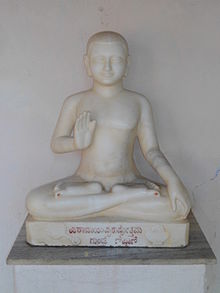Samantabhadra was a Digambara ācārya (head of the monastic order) who lived about the later part of the second century CE.[1][2] He was a proponent of the Jaina doctrine of Anekāntavāda. The Ratnakaranda śrāvakācāra is the most popular work of Samantabhadra. Samantabhadra lived after Umaswami but before Pujyapada.
Samantabhadra | |
|---|---|
 | |
| Personal life | |
| Born | 2nd century CE |
| Notable work(s) | Ratnakaranda śrāvakācāra, Āpta-mīmāṁsā, Jinaśatakam |
| Religious life | |
| Religion | Jainism |
| Sect | Digambara |
Life
editSamantabhadra is said to have lived from 150 CE to 250 CE. He was from southern India during the time of Chola dynasty. He was a poet, logician, eulogist and an accomplished linguist.[3] He is credited with spreading Jainism in southern India.[4]
Samantabhadra, in his early stage of asceticism, was attacked with a disease known as bhasmaka (the condition of insatiable hunger).[5] As, digambara monks don't eat more than once in a day, he endured great pain. Ultimately, he sought the permission of his preceptor to undertake the vow of Sallekhana.[6] The preceptor denied the permission and asked him to leave monasticism and get the disease cured.[5] After getting cured he again joined the monastic order and became a great Jaina ācārya.[7]
Thought
editSamantabhadra affirmed Kundakunda's theory of the two nayas - vyavahāranaya (‘mundane') and niścayanaya (ultimate, omniscient). He argued however that the mundane view is not false, but is only a relative form of knowledge mediated by language and concepts, while the ultimate view is an immediate form of direct knowledge.[8] Samantabhadra also developed further the Jaina theory of syādvāda.[citation needed]
Works
editJaina texts authored by Ācārya Samantabhadra include:[9]
- Ratnakaranda śrāvakācāra[10] (150 verses)- The Ratnakaranda śrāvakācāra discusses the conduct of a Śrāvaka (Jain laity) in detail.[4]
- Gandhahastimahabhasya, a monumental commentary on the Tattvartha Sutra. The Gandhahastimahābhāṣya, with the exception of its Maṅgalācaraṇa (salutation to the deity), is extant now.[11] The Maṅgalācaraṇa is known as the 'Devāgama stotra' or Āpta-mīmāṁsā.[4][12]
- Āpta-mīmāṁsā- A treatise of 114 verses, it discusses the Jaina concept of omniscience and the attributes of the Omniscient.[4][13]
- Svayambhūstotra (fifth century CE)[14] - A Sanskrit adoration of The Twenty-four Tīrthaṅkaras[15] - 143 verses.[4] It was later translated by Dhyanatray (1676-1726) in Agra.[14]
- Yuktyanuśāsana- Sixty-four verses in praise of Tīrthaṅkara Vardhamāna Mahāvīra[4].
- Jinaśatakam (Stutividyā)[16](116 verses)- Poetical work written in Sanskrit in praise of twenty-four Jinas.[17]
- Tattvānuśāsana[18]
Praise
editJinasena, in his celebrated work, Ādi purāṇa praises the Samantabhadra as[19]
Acharya Samantrabhadra’s glory reigned supreme among all poets, scholars, disputants, and preachers; he was like a jewel on their heads.
References
editCitations
edit- ^ Gokulchandra Jain 2015, p. 82.
- ^ Champat Rai Jain 1917, p. iv.
- ^ Natubhai Shah 2004, p. 48.
- ^ a b c d e f Natubhai Shah 2004, p. 49.
- ^ a b Vijay K. Jain 2015, p. xviii.
- ^ Long 2009, p. 110.
- ^ Vijay K. Jain 2015, p. xx.
- ^ Long 2009, p. 130.
- ^ Gokulchandra Jain 2015, p. 84.
- ^ Samantabhadra, Ācārya (1 July 2006), Ratnakaranda Shravakacara, Hindi Granth Karyalay, ISBN 9788188769049
- ^ Champat Rai Jain 1917, p. v.
- ^ Ghoshal 2002, p. 7.
- ^ Vijay K. Jain 2015, p. xvii.
- ^ a b Orsini & Schofield 1981, p. 89.
- ^ Vijay K. Jain 2015, p. xi.
- ^ Samantabhadrasvāmī (1969), Kevalajñānapraśnacūḍāmaṇi
- ^ Gokulchandra Jain 2015, p. 92.
- ^ Yougveer Jugalkishor (1925). Swami Samantbhadra (itihas).
- ^ Vijay K. Jain 2015, p. xv.
Sources
edit- Ghoshal, Saratchandra (2002), Āpta-mīmāṁsā of Āchārya Samantabhadra, Bharatiya Jnanpith, ISBN 9788126307241
- Jain, Vijay K. (2015), Acarya Samantabhadra's Svayambhustotra: Adoration of The Twenty-four Tirthankara, Vikalp Printers, ISBN 978-81-903639-7-6,
This article incorporates text from this source, which is in the public domain.
- Jain, Gokulchandra (2015), Samantabhadrabhāratī (1st ed.), Budhānā, Muzaffarnagar (U.P.): Achārya Shāntisāgar Chani Smriti Granthmala, ISBN 978-81-90468879
- Jain, Champat Rai (1917), The Ratna Karanda Sravakachara, The Central Jaina Publishing House,
This article incorporates text from this source, which is in the public domain.
- Long, Jeffery D. (2009), Jainism: An Introduction, I.B. Tauris, ISBN 978-1-84511-625-5
- Orsini, Francesca; Schofield, Katherine Butler, eds. (1981), Tellings and Texts: Music, Literature and Performance in North India, Open Book Publishers, ISBN 978-1-78374-105-2
- Shah, Natubhai (2004) [First published in 1998], Jainism: The World of Conquerors, vol. I, Motilal Banarsidass, ISBN 81-208-1938-1
Further reading
edit- Jain, Vijay K. (2016). Ācārya Samantabhadra’s Āptamīmāmsā (Devāgamastotra) आचार्य समन्तभद्र विरचित "आप्तमीमांसा". Dehradun: Vikalp Printers. ISBN 81-903639-8-0.
- Jain, Vijay K. (2016). Ācārya Samantabhadra’s Ratnakarandaka-śrāvakācāra. Dehradun: Vikalp Printers. ISBN 81-903639-9-9. OCLC 953615751.
- Jain, Vijay K. (2015). Ācārya Samantabhadra’s Svayambhūstotra आचार्य समन्तभद्र विरचित "स्वयम्भूस्तोत्र". Dehradun: Vikalp Printers. ISBN 81-903639-7-2.